2013 CHRYSLER TOWN AND COUNTRY tire size
[x] Cancel search: tire sizePage 527 of 699
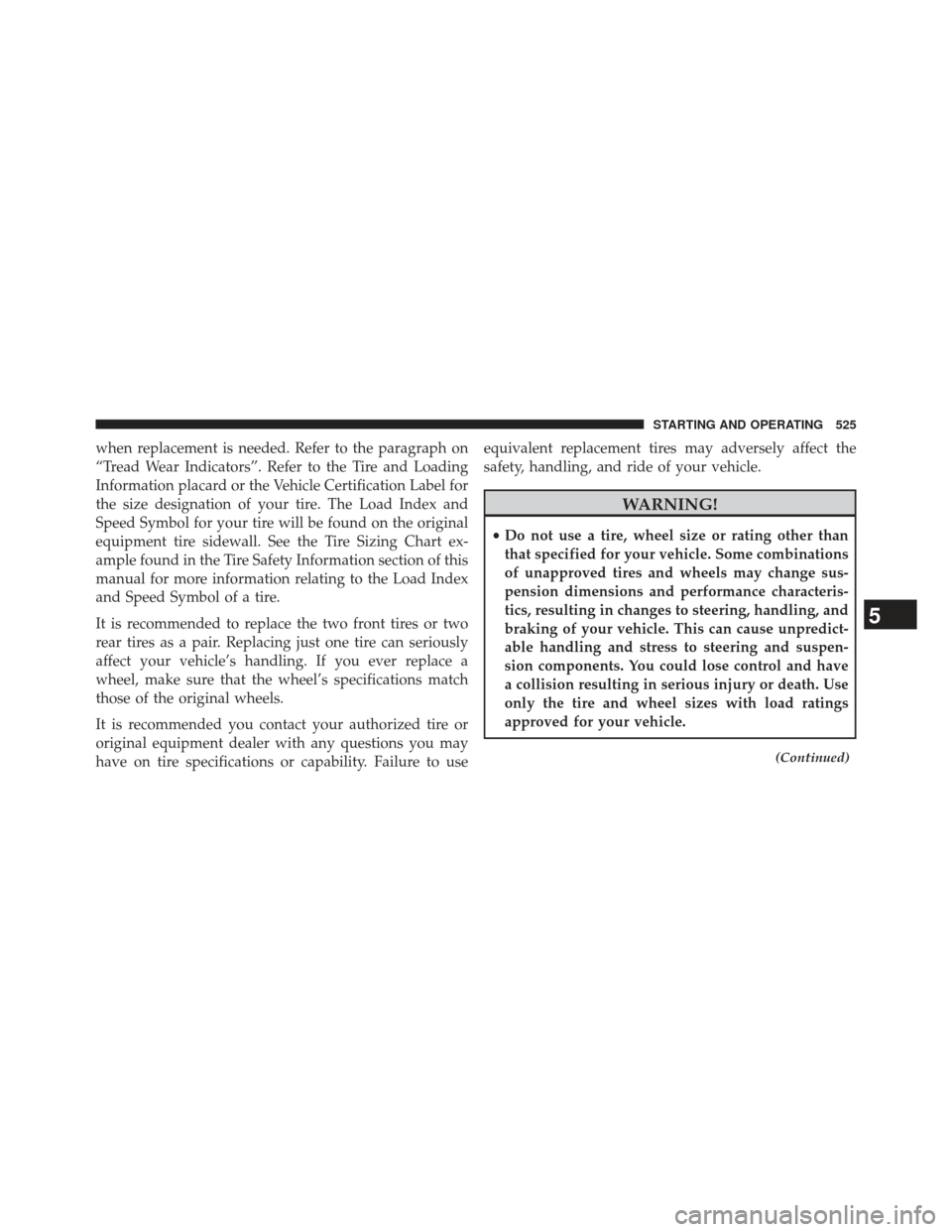
when replacement is needed. Refer to the paragraph on
“Tread Wear Indicators”. Refer to the Tire and Loading
Information placard or the Vehicle Certification Label for
the size designation of your tire. The Load Index and
Speed Symbol for your tire will be found on the original
equipment tire sidewall. See the Tire Sizing Chart ex-
ample found in the Tire Safety Information section of this
manual for more information relating to the Load Index
and Speed Symbol of a tire.
It is recommended to replace the two front tires or two
rear tires as a pair. Replacing just one tire can seriously
affect your vehicle’s handling. If you ever replace a
wheel, make sure that the wheel’s specifications match
those of the original wheels.
It is recommended you contact your authorized tire or
original equipment dealer with any questions you may
have on tire specifications or capability. Failure to useequivalent replacement tires may adversely affect the
safety, handling, and ride of your vehicle.
WARNING!
•
Do not use a tire, wheel size or rating other than
that specified for your vehicle. Some combinations
of unapproved tires and wheels may change sus-
pension dimensions and performance characteris-
tics, resulting in changes to steering, handling, and
braking of your vehicle. This can cause unpredict-
able handling and stress to steering and suspen-
sion components. You could lose control and have
a collision resulting in serious injury or death. Use
only the tire and wheel sizes with load ratings
approved for your vehicle.
(Continued)
5
STARTING AND OPERATING 525
Page 528 of 699
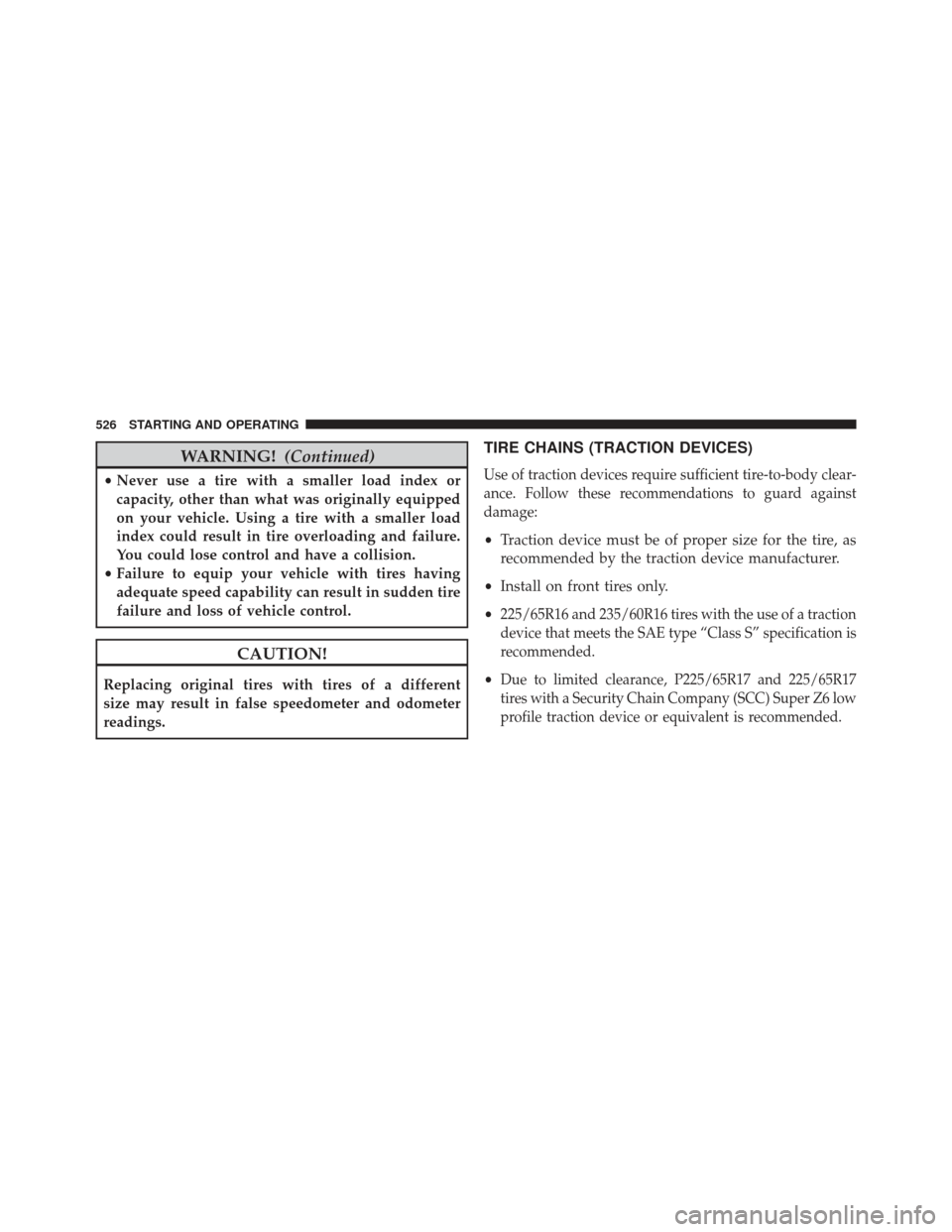
WARNING!(Continued)
•Never use a tire with a smaller load index or
capacity, other than what was originally equipped
on your vehicle. Using a tire with a smaller load
index could result in tire overloading and failure.
You could lose control and have a collision.
• Failure to equip your vehicle with tires having
adequate speed capability can result in sudden tire
failure and loss of vehicle control.
CAUTION!
Replacing original tires with tires of a different
size may result in false speedometer and odometer
readings.
TIRE CHAINS (TRACTION DEVICES)
Use of traction devices require sufficient tire-to-body clear-
ance. Follow these recommendations to guard against
damage:
• Traction device must be of proper size for the tire, as
recommended by the traction device manufacturer.
• Install on front tires only.
•
225/65R16 and 235/60R16 tires with the use of a traction
device that meets the SAE type “Class S” specification is
recommended.
•Due to limited clearance, P225/65R17 and 225/65R17
tires with a Security Chain Company (SCC) Super Z6 low
profile traction device or equivalent is recommended.
526 STARTING AND OPERATING
Page 529 of 699
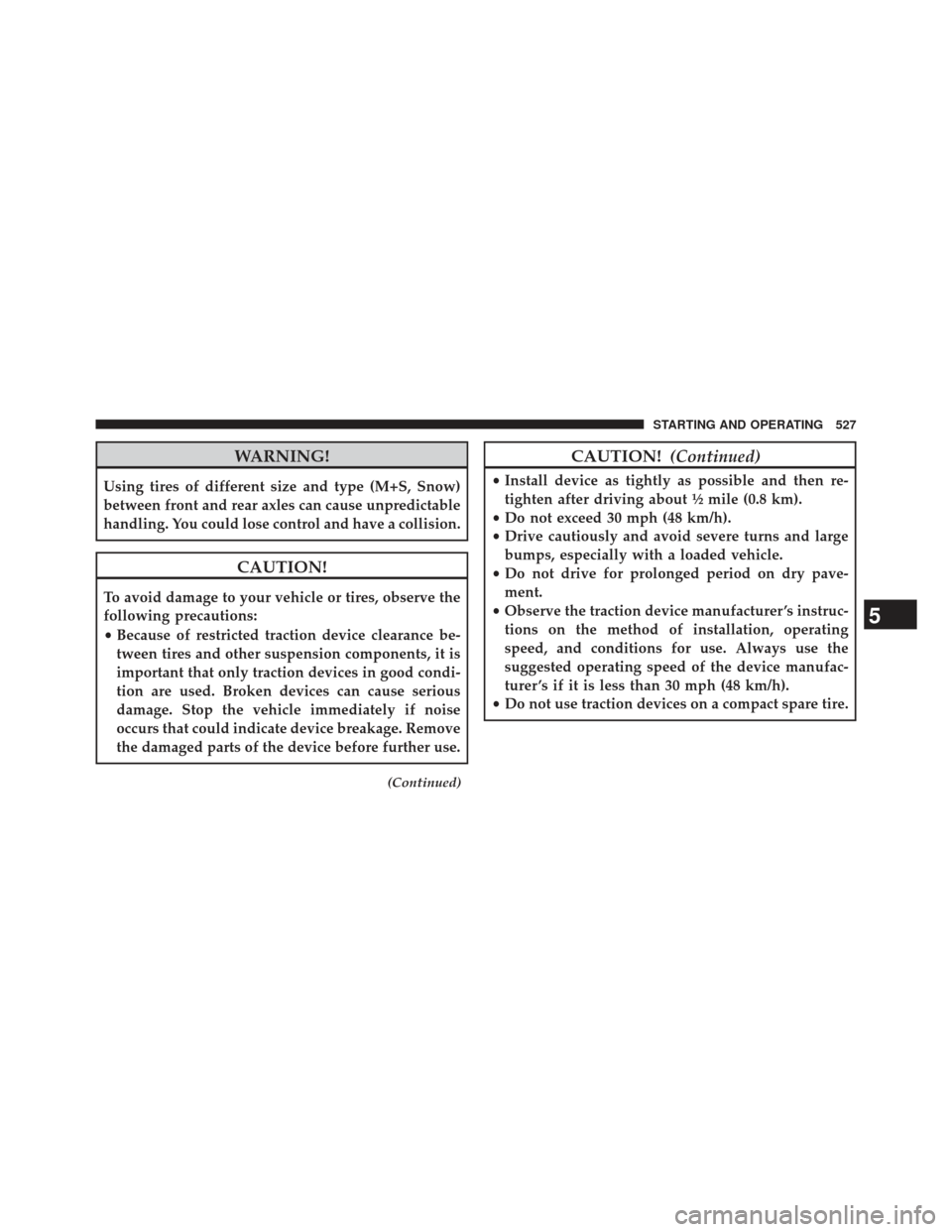
WARNING!
Using tires of different size and type (M+S, Snow)
between front and rear axles can cause unpredictable
handling. You could lose control and have a collision.
CAUTION!
To avoid damage to your vehicle or tires, observe the
following precautions:
•Because of restricted traction device clearance be-
tween tires and other suspension components, it is
important that only traction devices in good condi-
tion are used. Broken devices can cause serious
damage. Stop the vehicle immediately if noise
occurs that could indicate device breakage. Remove
the damaged parts of the device before further use.
(Continued)
CAUTION! (Continued)
•Install device as tightly as possible and then re-
tighten after driving about ½ mile (0.8 km).
• Do not exceed 30 mph (48 km/h).
• Drive cautiously and avoid severe turns and large
bumps, especially with a loaded vehicle.
• Do not drive for prolonged period on dry pave-
ment.
• Observe the traction device manufacturer ’s instruc-
tions on the method of installation, operating
speed, and conditions for use. Always use the
suggested operating speed of the device manufac-
turer ’s if it is less than 30 mph (48 km/h).
• Do not use traction devices on a compact spare tire.
5
STARTING AND OPERATING 527
Page 532 of 699
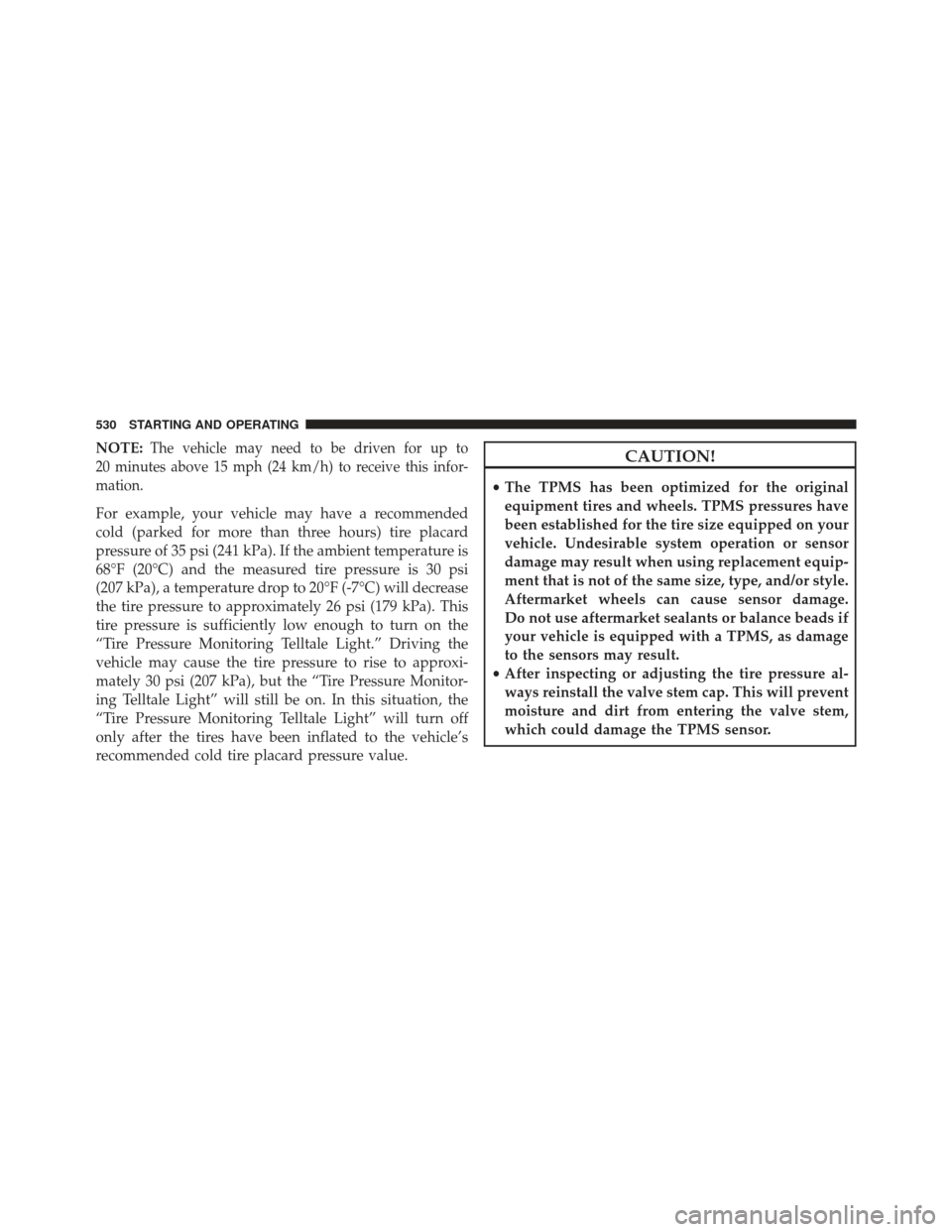
NOTE:The vehicle may need to be driven for up to
20 minutes above 15 mph (24 km/h) to receive this infor-
mation.
For example, your vehicle may have a recommended
cold (parked for more than three hours) tire placard
pressure of 35 psi (241 kPa). If the ambient temperature is
68°F (20°C) and the measured tire pressure is 30 psi
(207 kPa), a temperature drop to 20°F (-7°C) will decrease
the tire pressure to approximately 26 psi (179 kPa). This
tire pressure is sufficiently low enough to turn on the
“Tire Pressure Monitoring Telltale Light.” Driving the
vehicle may cause the tire pressure to rise to approxi-
mately 30 psi (207 kPa), but the “Tire Pressure Monitor-
ing Telltale Light” will still be on. In this situation, the
“Tire Pressure Monitoring Telltale Light” will turn off
only after the tires have been inflated to the vehicle’s
recommended cold tire placard pressure value.
CAUTION!
• The TPMS has been optimized for the original
equipment tires and wheels. TPMS pressures have
been established for the tire size equipped on your
vehicle. Undesirable system operation or sensor
damage may result when using replacement equip-
ment that is not of the same size, type, and/or style.
Aftermarket wheels can cause sensor damage.
Do not use aftermarket sealants or balance beads if
your vehicle is equipped with a TPMS, as damage
to the sensors may result.
• After inspecting or adjusting the tire pressure al-
ways reinstall the valve stem cap. This will prevent
moisture and dirt from entering the valve stem,
which could damage the TPMS sensor.
530 STARTING AND OPERATING
Page 552 of 699
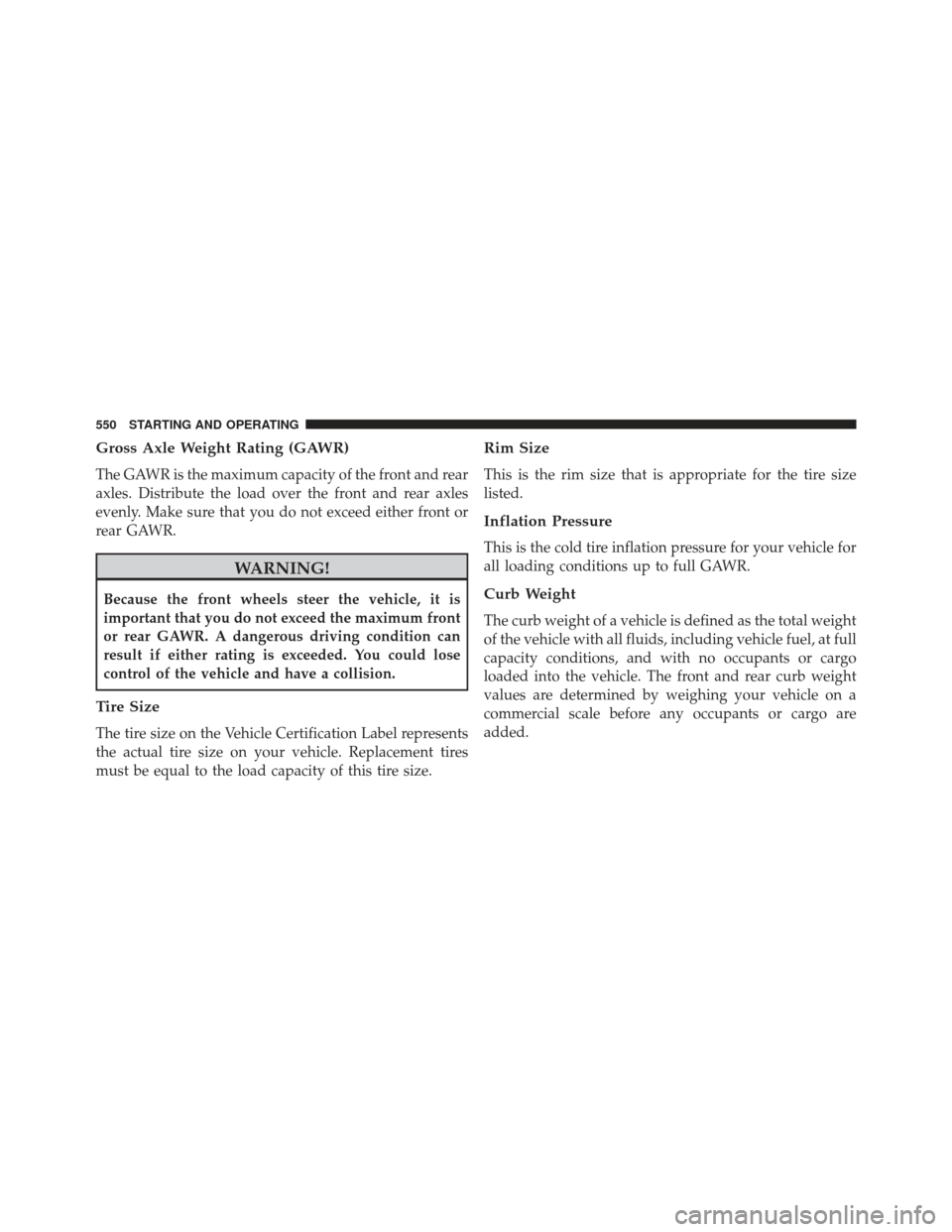
Gross Axle Weight Rating (GAWR)
The GAWR is the maximum capacity of the front and rear
axles. Distribute the load over the front and rear axles
evenly. Make sure that you do not exceed either front or
rear GAWR.
WARNING!
Because the front wheels steer the vehicle, it is
important that you do not exceed the maximum front
or rear GAWR. A dangerous driving condition can
result if either rating is exceeded. You could lose
control of the vehicle and have a collision.
Tire Size
The tire size on the Vehicle Certification Label represents
the actual tire size on your vehicle. Replacement tires
must be equal to the load capacity of this tire size.
Rim Size
This is the rim size that is appropriate for the tire size
listed.
Inflation Pressure
This is the cold tire inflation pressure for your vehicle for
all loading conditions up to full GAWR.
Curb Weight
The curb weight of a vehicle is defined as the total weight
of the vehicle with all fluids, including vehicle fuel, at full
capacity conditions, and with no occupants or cargo
loaded into the vehicle. The front and rear curb weight
values are determined by weighing your vehicle on a
commercial scale before any occupants or cargo are
added.
550 STARTING AND OPERATING
Page 588 of 699
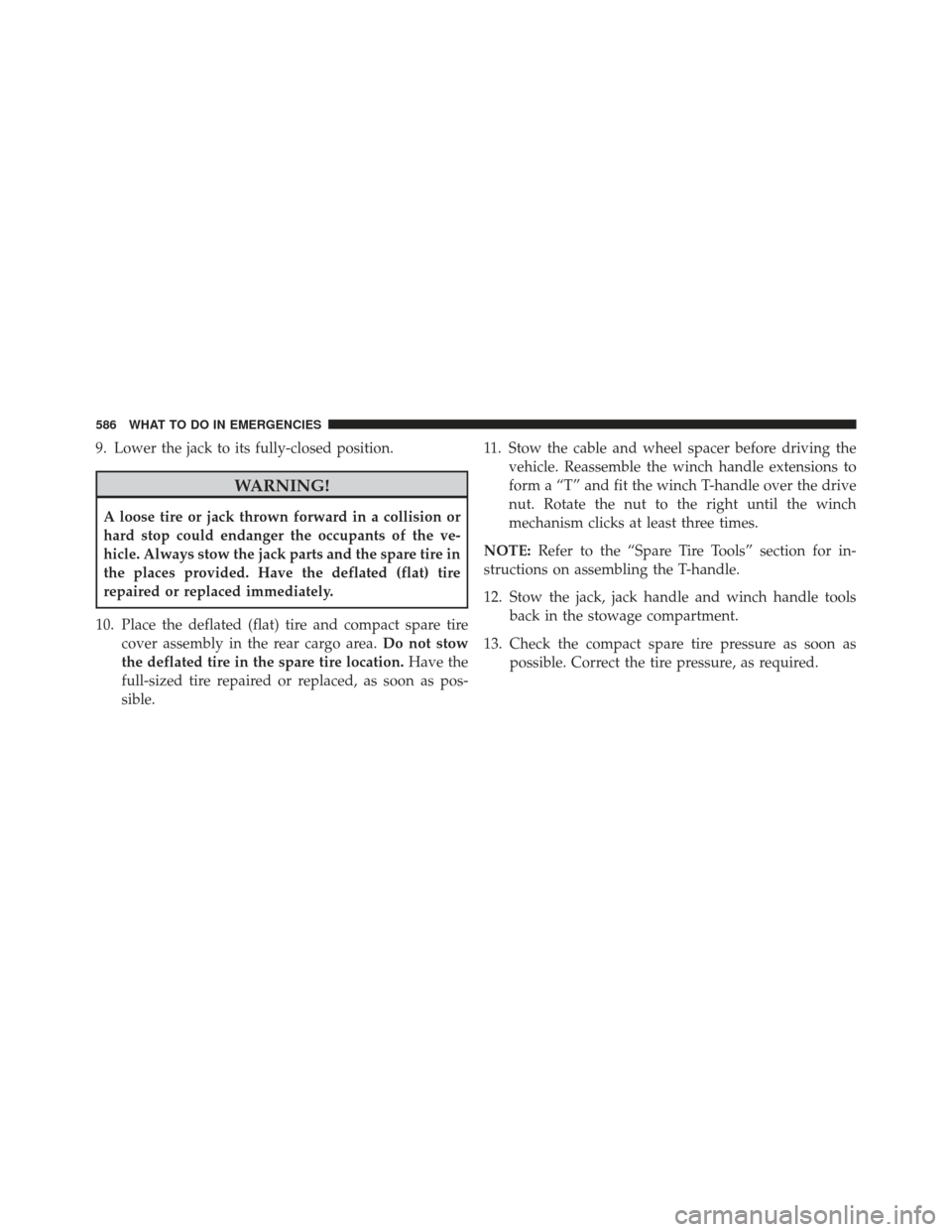
9. Lower the jack to its fully-closed position.
WARNING!
A loose tire or jack thrown forward in a collision or
hard stop could endanger the occupants of the ve-
hicle. Always stow the jack parts and the spare tire in
the places provided. Have the deflated (flat) tire
repaired or replaced immediately.
10. Place the deflated (flat) tire and compact spare tire cover assembly in the rear cargo area. Do not stow
the deflated tire in the spare tire location. Have the
full-sized tire repaired or replaced, as soon as pos-
sible. 11. Stow the cable and wheel spacer before driving the
vehicle. Reassemble the winch handle extensions to
form a “T” and fit the winch T-handle over the drive
nut. Rotate the nut to the right until the winch
mechanism clicks at least three times.
NOTE: Refer to the “Spare Tire Tools” section for in-
structions on assembling the T-handle.
12. Stow the jack, jack handle and winch handle tools back in the stowage compartment.
13. Check the compact spare tire pressure as soon as possible. Correct the tire pressure, as required.
586 WHAT TO DO IN EMERGENCIES
Page 590 of 699
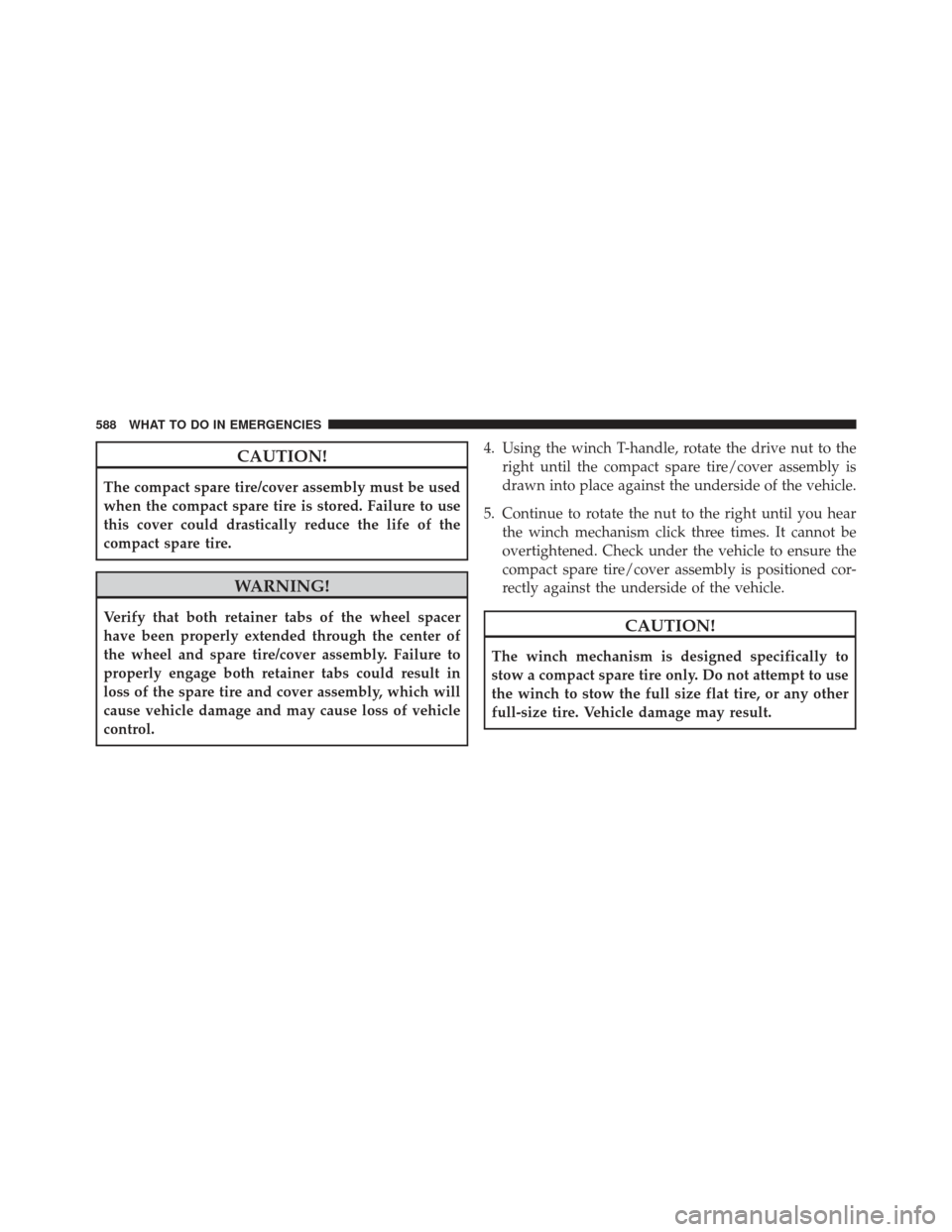
CAUTION!
The compact spare tire/cover assembly must be used
when the compact spare tire is stored. Failure to use
this cover could drastically reduce the life of the
compact spare tire.
WARNING!
Verify that both retainer tabs of the wheel spacer
have been properly extended through the center of
the wheel and spare tire/cover assembly. Failure to
properly engage both retainer tabs could result in
loss of the spare tire and cover assembly, which will
cause vehicle damage and may cause loss of vehicle
control.4. Using the winch T-handle, rotate the drive nut to the
right until the compact spare tire/cover assembly is
drawn into place against the underside of the vehicle.
5. Continue to rotate the nut to the right until you hear the winch mechanism click three times. It cannot be
overtightened. Check under the vehicle to ensure the
compact spare tire/cover assembly is positioned cor-
rectly against the underside of the vehicle.CAUTION!
The winch mechanism is designed specifically to
stow a compact spare tire only. Do not attempt to use
the winch to stow the full size flat tire, or any other
full-size tire. Vehicle damage may result.
588 WHAT TO DO IN EMERGENCIES
Page 695 of 699

Sunglasses Storage....................... .256
Sun Roof .............................. .269
Supplemental Restraint System - Airbag ..........79
Sway Control, Trailer ...................... .500
Synthetic Engine Oil .......................611
System, Remote Starting .....................30
Tachometer ............................. .315
Telescoping Steering Column .................235
Temperature Control, Automatic (ATC) ..........446
Temperature Gauge, Engine Coolant ............325
Tilt Steering Column ...................... .235
Tire and Loading Information Placard ...........511
Tire Markings ........................... .504
Tires ................................. .125
Aging (Life of Tires) .....................524
Air Pressure .......................... .515
Chains .............................. .526
Changing ............................ .571Compact Spare
........................ .521
General Information .....................515
High Speed .......................... .518
Inflation Pressures ...................... .517
Jacking .............................. .571
Life of Tires .......................... .524
Load Capacity .........................511
Pressure Monitor System (TPMS) ............529
Pressure Warning Light ...................319
Quality Grading ....................... .673
Radial .............................. .519
Replacement .......................... .524
Rotation ............................. .528
Safety .............................. .504
Sizes ............................... .506
Snow Tires ........................... .520
Spare Tire ............................ .573
Spinning ............................ .523
T
railer Towing ........................ .561
10
INDEX 693